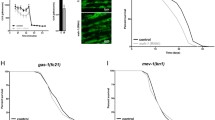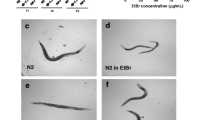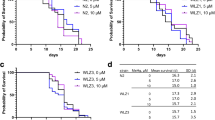Abstract
Excessive levels of the essential metal manganese (Mn) may cause a syndrome similar to Parkinson’s disease. The model organism Caenorhabditis elegans mimics some of Mn effects in mammals, including dopaminergic neurodegeneration, oxidative stress, and increased levels of AKT. The evolutionarily conserved insulin/insulin-like growth factor-1 signaling pathway (IIS) modulates worm longevity, metabolism, and antioxidant responses by antagonizing the transcription factors DAF-16/FOXO and SKN-1/Nrf-2. AKT-1, AKT-2, and SGK-1 act upstream of these transcription factors. To study the role of these proteins in C. elegans response to Mn intoxication, wild-type N2 and loss-of-function mutants were exposed to Mn (2.5 to 100 mM) for 1 h at the L1 larval stage. Strains with loss-of-function in akt-1, akt-2, and sgk-1 had higher resistance to Mn compared to N2 in the survival test. All strains tested accumulated Mn similarly, as shown by ICP-MS. DAF-16 nuclear translocation was observed by fluorescence microscopy in WT and loss-of-function strains exposed to Mn. qRT-PCR data indicate increased expression of γ-glutamyl cysteine synthetase (GCS-1) antioxidant enzyme in akt-1 mutants. The expression of sod-3 (superoxide dismutase homologue) was increased in the akt-1 mutant worms, independent of Mn treatment. However, dopaminergic neurons degenerated even in the more resistant strains. Dopaminergic function was evaluated with the basal slowing response behavioral test and dopaminergic neuron integrity was evaluated using worms expressing green fluorescent protein (GFP) under the dopamine transporter (DAT-1) promoter. These results suggest that AKT-1/2 and SGK-1 play a role in C. elegans response to Mn intoxication. However, tissue-specific responses may occur in dopaminergic neurons, contributing to degeneration.








Similar content being viewed by others
References
Aitlhadj L, Avila DS, Benedetto A, Aschner M, Stürzenbaum SR (2011) Environmental exposure, obesity and Parkinson’s disease: lessons from fat and old worms. Environ Health Perspect 119:20–28
Altun ZF, Hall DH (2011) Nervous system, general description. https://doi.org/10.3908/wormatlas.1.18
An JH, Blackwell TK (2003) SKN-1 links C. elegans mesendodermal specification to a conserved oxidative stress response. Genes Dev 17:1882–1893. https://doi.org/10.1101/gad.1107803
Apfeld J, O'Connor G, McDonagh T, DiStefano PS, Curtis R (2004) The AMP-activated protein kinase AAK-2 links energy levels and insulin-like signals to lifespan in C. elegans. Genes Dev 18:3004–3009. https://doi.org/10.1101/gad.1255404
Aschner M, Erikson K, Hernández E, Tjalkens R (2009) Manganese and its role in Parkinson’s disease: from transport to neuropathology. NeuroMolecular Med 11:252–266. https://doi.org/10.1007/s12017-009-8083-0
Au C, Benedetto A, Anderson J, Labrousse A, Erikson K, Ewbank JJ, Aschner M (2009) SMF-1, SMF-2 and SMF-3 DMT1 orthologues regulate and are regulated differentially by manganese levels in C. elegans. PLoS One 4:e7792. https://doi.org/10.1371/journal.pone.0007792
Avila DS et al (2012a) Organotellurium and organoselenium compounds attenuate Mn-induced toxicity in Caenorhabditis elegans by preventing oxidative stress. Free Radic Biol Med 52:1903–1910. https://doi.org/10.1016/j.freeradbiomed.2012.02.044
Avila DS, Somlyai G, Somlyai I, Aschner M (2012b) Anti-aging effects of deuterium depletion on Mn-induced toxicity in a C. elegans model. Toxicol Lett 211:319–324. https://doi.org/10.1016/j.toxlet.2012.04.014
Avila DS, Benedetto A, Au C, Bornhorst J, Aschner M (2016) Involvement of heat shock proteins on Mn-induced toxicity in Caenorhabditis elegans. BMC Pharmacol Toxicol 17:54. https://doi.org/10.1186/s40360-016-0097-2
Benedetto A, Au C, Avila DS, Milatovic D, Aschner M (2010) Extracellular dopamine potentiates Mn-induced oxidative stress, lifespan reduction, and dopaminergic neurodegeneration in a BLI-3-dependent manner in Caenorhabditis elegans. PLoS Genet 6(8):e1001084. https://doi.org/10.1371/journal.pgen.1001084
Blackwell TK, Steinbaugh MJ, Hourihan JM, Ewald CY, Isik M (2015) SKN-1/Nrf, stress responses, and aging in Caenorhabditis elegans. Free Radic Biol Med 88:290–301. https://doi.org/10.1016/j.freeradbiomed.2015.06.008
Bornhorst J et al (2014) The effects of pdr1, djr1.1 and pink1 loss in manganese-induced toxicity and the role of α-synuclein in C. elegans. Metallomics 6:476–490. https://doi.org/10.1039/C3MT00325F
Bowerman B, Eaton BA, Priess JR (1992) skn-1, a maternally expressed gene required to specify the fate of ventral blastomeres in the early C. elegans embryo. Cell 68:1061–1075
Brenner S (1974) The genetics of Caenorhabditis elegans. Genetics 77:71–94
Brickley DR et al (2013) Serum- and glucocorticoid-induced protein kinase 1 (SGK1) is regulated by store-operated Ca2+ entry and mediates cytoprotection against necrotic cell death. J Biol Chem 288:32708–32719. https://doi.org/10.1074/jbc.M113.507210
Brinkhaus SG et al (2014) Elemental bioimaging of manganese uptake in C. elegans. Metallomics 6:617–621. https://doi.org/10.1039/C3MT00334E
Brunet A, Datta SR, Greenberg ME (2001) Transcription-dependent and -independent control of neuronal survival by the PI3K-Akt signaling pathway. Curr Opin Neurobiol 11:297–305
Bryan MR et al (2017) Phosphatidylinositol 3 kinase (PI3K) modulates manganese homeostasis and manganese-induced cell signaling in a murine striatal cell line. Neurotoxicology. https://doi.org/10.1016/j.neuro.2017.07.026
Burnette WN (1981) “Western blotting”: electrophoretic transfer of proteins from sodium dodecyl sulfate-polyacrylamide gels to unmodified nitrocellulose and radiographic detection with antibody and radioiodinated protein A. Anal Biochem 112:195–203. https://doi.org/10.1016/0003-2697(81)90281-5
Chen AT, Guo C, Dumas KJ, Ashrafi K, Hu PJ (2013) Effects of Caenorhabditis elegans sgk-1 mutations on lifespan, stress resistance, and DAF-16/FoxO regulation. Aging Cell 12:932–940. https://doi.org/10.1111/acel.12120
Cordova FM et al (2012) In vivo manganese exposure modulates Erk, Akt and Darpp-32 in the striatum of developing rats, and impairs their motor function. PLoS One 7:e33057. https://doi.org/10.1371/journal.pone.0033057
Cordova F et al (2013) Manganese-exposed developing rats display motor deficits and striatal oxidative stress that are reversed by Trolox. Arch Toxicol 1–14. https://doi.org/10.1007/s00204-013-1017-5
Farina M, Avila DS, da Rocha JB, Aschner M (2013) Metals, oxidative stress and neurodegeneration: a focus on iron, manganese and mercury. Neurochem Int 62:575–594. https://doi.org/10.1016/j.neuint.2012.12.006
Friedman DB, Johnson TE (1988) A mutation in the age-1 gene in Caenorhabditis elegans lengthens life and reduces hermaphrodite fertility. Genetics 118:75–86
Gatsi R, Schulze B, Rodriguez-Palero MJ, Hernando-Rodriguez B, Baumeister R, Artal-Sanz M (2014) Prohibitin-mediated lifespan and mitochondrial stress implicate SGK-1, insulin/IGF and mTORC2 in C. elegans. PLoS One 9:e107671. https://doi.org/10.1371/journal.pone.0107671
Guilarte TR (2013) Manganese neurotoxicity: new perspectives from behavioral, neuroimaging, and neuropathological studies in humans and non-human primates. Front Aging Neurosci 5:23. https://doi.org/10.3389/fnagi.2013.00023
Hall JA, McElwee MK, Freedman JH (2017) Identification of ATF-7 and the insulin signaling pathway in the regulation of metallothionein in C. elegans suggests roles in aging and reactive oxygen species. PLoS One 12:e0177432. https://doi.org/10.1371/journal.pone.0177432
Hashmi S, Wang Y, Parhar RS, Collison KS, Conca W, Al-Mohanna F, Gaugler R (2013) A C. elegans model to study human metabolic regulation. Nutrition & Metabolism 10:31. https://doi.org/10.1186/1743-7075-10-31
Hertweck M, Göbel C, Baumeister R (2004) C. elegans SGK-1 is the critical component in the Akt/PKB kinase complex to control stress response and life span. Dev Cell 6:577–588. https://doi.org/10.1016/S1534-5807(04)00095-4
Honda Y, Honda S (1999) The daf-2 gene network for longevity regulates oxidative stress resistance and Mn-superoxide dismutase gene expression in Caenorhabditis elegans. FASEB J 13:1385–1393
Hsu AL, Murphy CT, Kenyon C (2003) Regulation of aging and age-related disease by DAF-16 and heat-shock factor. Science 300:1142–1145. https://doi.org/10.1126/science.1083701
Kaletsky R, Lakhina V, Arey R, Williams A, Landis J, Ashraf J, Murphy CT (2016) The C. elegans adult neuronal IIS/FOXO transcriptome reveals adult phenotype regulators. Nature 529:92–96. https://doi.org/10.1038/nature16483
Kenyon C (2011) The first long-lived mutants: discovery of the insulin/IGF-1 pathway for ageing. Philos Trans R Soc Lond Ser B Biol Sci 366:9–16. https://doi.org/10.1098/rstb.2010.0276
Kenyon C, Chang J, Gensch E, Rudner A, Tabtiang R (1993) A C. elegans mutant that lives twice as long as wild type. Nature 366:461. https://doi.org/10.1038/366461a0
Klass MR (1983) A method for the isolation of longevity mutants in the nematode Caenorhabditis elegans and initial results. Mech Ageing Dev 22:279–286
Lin K, Hsin H, Libina N, Kenyon C (2001) Regulation of the Caenorhabditis elegans longevity protein DAF-16 by insulin/IGF-1 and germline signaling. Nat Genet 28:139–145. https://doi.org/10.1038/88850
Livak KJ, Schmittgen TD (2001) Analysis of relative gene expression data using real-time quantitative PCR and the 2−ΔΔCT method. Methods 25:402–408. https://doi.org/10.1006/meth.2001.1262
Mair W, Morantte I, Rodrigues APC, Manning G, Montminy M, Shaw RJ, Dillin A (2011) Lifespan extension induced by AMPK and calcineurin is mediated by CRTC-1 and CREB. Nature 470:404–U179. https://doi.org/10.1038/nature09706
Michaelson D, Korta DZ, Capua Y, Hubbard EJ (2010) Insulin signaling promotes germline proliferation in C. elegans. Development 137:671–680. https://doi.org/10.1242/dev.042523
Moreno-Arriola E, El Hafidi M, Ortega-Cuellar D, Carvajal K (2016) AMP-activated protein kinase regulates oxidative metabolism in Caenorhabditis elegans through the NHR-49 and MDT-15 transcriptional regulators. PLoS One 11:e0148089. https://doi.org/10.1371/journal.pone.0148089
Morley JF, Morimoto RI (2004) Regulation of longevity in Caenorhabditis elegans by heat shock factor and molecular chaperones. Mol Biol Cell 15:657–664. https://doi.org/10.1091/mbc.E03-07-0532
Ogg S, Paradis S, Gottlieb S, Patterson GI, Lee L, Tissenbaum HA, Ruvkun G (1997) The Fork head transcription factor DAF-16 transduces insulin-like metabolic and longevity signals in C. elegans. Nature 389:994–999. https://doi.org/10.1038/40194
Paradis S, Ruvkun G (1998) Caenorhabditis elegans Akt/PKB transduces insulin receptor-like signals from AGE-1 PI3 kinase to the DAF-16 transcription factor. Genes Dev 12:2488–2498
Rahman I, Kode A, Biswas SK (2007) Assay for quantitative determination of glutathione and glutathione disulfide levels using enzymatic recycling method. Nat Protocols 1:3159–3165
Rand JB, Nonet ML (1997) Components regulating neurotransmitter release in all neurons. In: Riddle DL, Blumenthal T, Meyer BJ, et al (eds) C. elegans II, 2nd edition. Cold Spring Harbor Laboratory Press, Cold Spring Harbor (NY). Available from: https://www.ncbi.nlm.nih.gov/books/NBK19991/. Accessed 16 Mar 2018
Sawin ER, Ranganathan R, Horvitz HR (2000) C. elegans locomotory rate is modulated by the environment through a dopaminergic pathway and by experience through a serotonergic pathway. Neuron 26:619–631. https://doi.org/10.1016/S0896-6273(00)81199-X
Settivari R, VanDuyn N, LeVora J, Nass R (2013) The Nrf2/SKN-1-dependent glutathione S-transferase π homologue GST-1 inhibits dopamine neuron degeneration in a Caenorhabditis elegans model of manganism. NeuroToxicology 38:51–60. https://doi.org/10.1016/j.neuro.2013.05.014
Singaravelu G, Singson A (2013) Calcium signaling surrounding fertilization in the nematode Caenorhabditis elegans. Cell Calcium 53:2–9. https://doi.org/10.1016/j.ceca.2012.11.009
Smith PK et al. (1985) Measurement of protein using bicinchoninic acid. Anal Biochem 150:76–85. https://doi.org/10.1016/0003-2697(85)90442-7
Srivastava VK, Hiney JK, Dees WL (2016) Manganese-stimulated kisspeptin is mediated by the IGF-1/Akt/mammalian target of rapamycin pathway in the Prepubertal female rat. Endocrinology 157:3233–3241. https://doi.org/10.1210/en.2016-1090
Sulston JE (1976) Post-embryonic development in the ventral cord of Caenorhabditis elegans. Philos Trans R Soc Lond Ser B Biol Sci 275:287–297
Sulston J, Hodgkin J (1988) Methods. Cold Spring Harbor Monograph Archive, North America, 17, Available at: https://cshmonographs.org/index.php/monographs/article/view/5032. Date accessed: 16 Mar 2018
Tullet JM et al (2008) Direct inhibition of the longevity-promoting factor SKN-1 by insulin-like signaling in C. elegans. Cell 132:1025–1038. https://doi.org/10.1016/j.cell.2008.01.030
Tullet JMA et al (2014) DAF-16/FoxO directly regulates an atypical AMP-activated protein kinase gamma isoform to mediate the effects of insulin/IGF-1 signaling on aging in Caenorhabditis elegans. PLoS Genet 10:e1004109. https://doi.org/10.1371/journal.pgen.1004109
Wang S, Teng X, Wang Y, Yu HQ, Luo X, Xu A, Wu L (2014) Molecular control of arsenite-induced apoptosis in Caenorhabditis elegans: roles of insulin-like growth factor-1 signaling pathway. Chemosphere 112:248–255. https://doi.org/10.1016/j.chemosphere.2014.04.021
Warnhoff K et al (2014) The DAF-16 FOXO transcription factor regulates natc-1 to modulate stress resistance in Caenorhabditis elegans, linking insulin/IGF-1 signaling to protein N-terminal acetylation. PLoS Genet 10:e1004703. https://doi.org/10.1371/journal.pgen.1004703
Williams BB et al (2010) Disease-toxicant screen reveals a neuroprotective interaction between Huntington’s disease and manganese exposure. J Neurochem 112:227–237. https://doi.org/10.1111/j.1471-4159.2009.06445.x
Wollenhaupt SGN et al (2014) Seleno- and telluro-xylofuranosides attenuate Mn-induced toxicity in C. elegans via the DAF-16/FOXO pathway. Food Chem Toxicol 64:192–199. https://doi.org/10.1016/j.fct.2013.11.030
Yang DD et al (1997) Absence of excitotoxicity-induced apoptosis in the hippocampus of mice lacking the Jnk3 gene. Nature 389:865–870. https://doi.org/10.1038/39899
Zeke A, Misheva M, Remenyi A, Bogoyevitch MA (2016) JNK signaling: regulation and functions based on complex protein-protein partnerships. Microbiol Mol Biol Rev 80:793–835. https://doi.org/10.1128/MMBR.00043-14
Funding
TVP received a fellowship from Coordenação de Aperfeiçoamento de Pessoal de Nível Superior (CAPES) Foundation, Ministry of Education of Brazil, (Proc. #0407/13-5). LA received a fellowship from Conselho Nacional de Desenvolvimento Científico e Tecnológico (CNPq, 202662/2014-4 - SWE). MA and ABB were supported by National Institute of Healt (NIH) R01 ES10563. MA was also supported by R01 ES07331 and R01 ES020852. We thank the “Deutsche Forschungsgemeinschaft” (DFG) further for the financial support of Schw 903/9-1 and BO 4103/2-1. Images were obtained at the Analytical Imaging Facility of the Albert Einstein College of Medicine [NCI cancer center support grant (P30CA013330)]. Some strains were provided by the CGC, which is funded by NIH Office of Research Infrastructure Programs (P40 OD010440). Funding agencies had no role in the study design, data collection and analysis, decision to publish, or preparation of the manuscript.
Author information
Authors and Affiliations
Corresponding author
Ethics declarations
Conflict of Interest
The authors declare that they have no conflict of interest.
Electronic supplementary material
Supplemental Fig.1
Confocal microscopy images depicting alterations in GFP marking of dopaminergic neurons. A and B depict a normal worm. C depicts a worm with puncta (arrow heads). D depicts a worm with a shrunken soma (arrows). C and D were considered worms with degeneration. Worms were in the L1 stage. Green scale bar = 10 μm (×40 objective). White scale bar = 13 μm (×60 objective). (PNG 3287 kb)
Rights and permissions
About this article
Cite this article
Peres, T.V., Arantes, L.P., Miah, M.R. et al. Role of Caenorhabditis elegans AKT-1/2 and SGK-1 in Manganese Toxicity. Neurotox Res 34, 584–596 (2018). https://doi.org/10.1007/s12640-018-9915-1
Received:
Revised:
Accepted:
Published:
Issue Date:
DOI: https://doi.org/10.1007/s12640-018-9915-1




